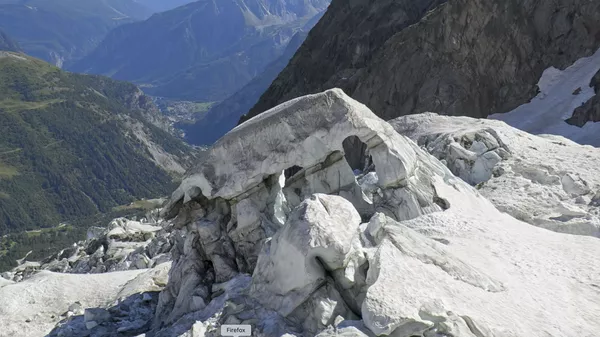Alpine glaciers that are melting due to the effects of climate change are laying bare a prehistoric treasure-trove that is in danger of disappearing, spurring archaeologists to race against time to salvage the artefacts.
While scientists acknowledge the devastating toll that climate change is fraught with, it has opened up fresh opportunities for a separate field of research called glacier archaeology.
"We are making very fascinating finds that open up a window into a part of archaeology that we don't normally get," Marcel Cornelissen, who headed an excavation trip in September to a remote crystal site near the Brunifirm glacier in the eastern Swiss canton of Uri, was cited as saying by AFP.
Millennia of Mountain Life
Recent discoveries have been overturning previous theories that people in prehistoric times did not venture up intimidating mountains.
If the artefacts laid bare by the melting ice are anything to go by, mountain ranges like the Alps were investigated by ancient man for the purpose of hunting, putting animals out to pastures, and in the search for raw materials.
Glaciers in Oppland (🇳🇴) are melting. Artefacts that survived within them for millennia are being exposed and destroyed.
— 🅰ntiquity Journal is publishing from home (@AntiquityJ) February 4, 2020
📸: Where the tunic was found pic.twitter.com/PmDlAJJpzE
The body of a 5,300-year-old warrior, dubbed "Oetzi" which had been preserved inside an Alpine glacier in the Italian region of Tyrol, was the first major Alpine find in 1991.
Funde aus dem Eis wurden in einer Art konserviert, wie es im Erdboden mit seinen Mikroorganismen nicht möglich ist. Bei #Ötzi konnte man noch 5000 Jahre nach seinem Tod Mageninhalt und Erbgut analysieren.#sagw_blog #sagw_gletscher #gletscherarchäologiehttps://t.co/5vSll1y3AC pic.twitter.com/L5siy40MXR
— SAGW (@SAGW_CH) May 10, 2019
This was followed up by the discovery of a birch bark quiver dating as far back as 3,000 BCE in the Schnidejoch pass of the Bernese Alps, 2,756 metres (9,000 feet) above sea level.
Subsequently, leather trousers and shoes were also discovered, along with hundreds of other objects dating as far back as about 4,500 BCE. In September, archaeologists excavating the site in Schnidejoch came upon a knotted string of bast, or plant fibres suggested as dating back 6,000 years.
Der Archäologische Dienst #Bern gibt Informationsflyer zu archäologischen Funden heraus, u.a. zum #Schnidejoch und zum #Lötschenpass. Sie halten fest, was nach Abschluss von archäologischen Untersuchungen oft nicht mehr sichtbar ist.#gletscherarchäologiehttps://t.co/HJlgcHaaDy pic.twitter.com/ghSKfLQbYw
— SAGW (@SAGW_CH) July 19, 2019
"It is exciting because we find stuff that we don't normally find in excavations," archaeologist Regula Gubler told AFP.
Norway's Melting Glaciers Reveal Viking & Iron Age Finds
— Textile Institute (@textileinst) April 22, 2020
Melting glacier ice on the #Lendbreen Pass #Norway uncovers an ancient trade route & artefacts including an #IronAge tunic, a #Viking #mitten, & the #spinning #distaff pictured#TextileHistoryhttps://t.co/uwbE7C8PaJ pic.twitter.com/g2O582wH2k
The expert added that such organic materials would typically be lost to erosion if it were not for the ice preserving them intact.
#Climatechange impact? #Norway's melting glaciers reveal #Viking-era artefacts https://t.co/Bg8sWcTV9t #archaeology pic.twitter.com/MmBlOFhqvJ
— Debborah Donnelly (@DebbyDonnelly) April 20, 2020
At the same time, the archaeologists warn that time may be running out for these treasures, acknowledging that understanding of glacier sites' archaeological potential possibly arrived "too late".
"It is a very short window in time. In 20 years, these finds will be gone and these ice patches will be gone… It is a bit stressful," said Gubler.
"The retreat of the glaciers and melting of the ice fields has already progressed so far… I don't think we'll find another Oetzi," added Marcel Cornelissen.
As they race against time, archaeologists have been urging hikers and others to alert them to finds.
"We need to urgently sensibilise populations likely to come across such artefacts… It is an archaeological emergency,” Pierre Yves Nicod, an archaeologist with the Wallis historical museum in Sion was quoted as saying.




